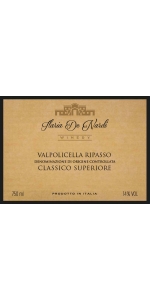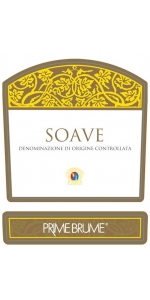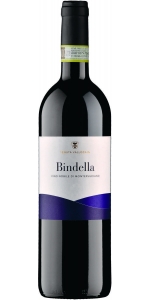Gambellara Soave I Basalti 2019
| Country: | Italy |
| Regions: | Veneto Soave |
| Winery: | Cantina di Gambellara |
| Grape Type: | Garganega |
| Vintage: | 2019 |
| Bottle Size: | 750 ml |
Color: Soft and bright straw yellow
Bouquet: A citrus fresh fruit bouquet
Taste: Slightly acid, fresh, with green apple hints
Perlage: A fine and persistent perlage
The grapes are collected and transported to the winery in small trailers to prevent the grapes from being squashed, then follows immediate separation of the skins from the stalks purifying of the must and long fermentation at 18 °C.
This is a Charmat method (The secondary fermentation didn't take place in the bottle, but in a vat, which makes it slightly different than the Champenoise method used in Champagne).
To serve with seafood starters, soups, egg dishes, shellfish, seafood and white meat. Very good as aperitif. The perfect match is with the "Baccalà alla Vicentina", the traditional dish of our land.
Review:
This Brut-style fizz with 10g/L residual sugar is made from the ancient Durella grape in the same way as Prosecco, where the second fermentation is in tank, not the bottle. It shows ripe, exotic flavours, a crisp apple bite and a mineral finish. An unusual and appealing aperitif. - Tina Gellie" - Decanter (January 2019), 90 pts"
Ilaria De Nardi Valpolicella Ripasso Classico Superiore is made from 60% Corvina, 20% Rondinella, 20% Corvinoni
Intense red color with garnet hints. Almond and fresh walnut aromas. Full-bodied with a good structure.
This is an excellent red wine with a supple body. The techniques used to produce this wine is typical from the area.
Excellent with cold cut, fresh and mature cheeses. Perfect with red meat and game.
Late harvest style Corvina aged on Amarone lees. The must of Amarone remains in the vat and instead of being pressed, it is topped up with high quality Valpolicella before being left to referment for about 10-15 days.
Pairs well with roasted meats.
The color is a brilliant straw yellow with a fresh fruit perfumes, especially apple and pear, and floral notes such as elder and bloom. The taste is very fresh and light, with a very interesting acidity. There is an important presence of mineral salts due to the volcanic origin of the soil.
Open pergola Vinification: Destemming, maceration of the grapes in the must for 12 hours, racking and long fermentation at 18 °C
Ideal as aperitif, light main courses such as pasta and risotto, shell fish and fish, soups and vegetables.
Review:
Brilliant emerald straw color. Aromas and flavors of brazil nuts, creme fraiche, and kiwi and starfruit with a silky, lively, dry-yet-fruity light-to-medium body and an effortless, engaging, medium-length watermelon, yellow apple, and clementine finish. A delicious, artfully balanced soave with a great range of fruit flavors. 91 Point Beverage Tasting Institue
G.D. Vajra Bricco Delle Viole Barolo is made from 100 percent Nebbiolo.
The Barolo Bricco delle Viole shows the signature verticality of its vineyard. The wine is beautifully layered and - while restrained as it’s always the case in the youth of Bricco delle Viole - it also shows a complexity of layers with purple flowers, sweet spices and mineral tones. The palate is noble, with a refined acid spine and profound tannins that promise a long aging potential.
Among the historical vineyards of Barolo, Bricco delle Viole is the highest and the closest to the Alps. It rises from 400 to 480 meters above sea level, on the Western ridge of the village. Its name, “Hill of Violets”, originates from the flowers that blossom early here due to the perfect south exposure. Up above the fogs, Bricco delle Viole enjoys the earliest sunrise and the last sunset every day. Thanks to its vines dating back to 1949 and -now- 1931, a dramatic diuturnal temperature range and this pure light, Bricco delle Viole generates a sophisticated and profound Barolo DOCG of bright aromatics, chiseled tannins and subtle minerality. 2018 is a vintage that shows many nuances of Bricco delle Viole: beyond the signature verticality of this site, the wine offers high tones laced with mineral nuances and plenty of energy and youth.
Review:
A juicy Barolo, with vibrant acidity and a fluid profile that exudes cherry, raspberry, mown hay, mineral and eucalyptus aromas and flavors. Tight yet long, with excellent potential.
#26 Wine Spectator Top 100 of 2023
The last wine poured at my tasting at the winery is the G.D. Vajra 2019 Barolo Bricco delle Viole. With its high vantage point in the hills west of Barolo, Bricco delle Viole is a world apart in terms of soils (with Sant'Agata marl and fossils) and even harvest times. Slow and careful ripening like the kind that characterizes fruit in 2019 renders a very delicate and ethereal expression with floral tones, wild mint and licorice. This organic wine is solid in build and structure. Indeed, Isidoro Vaira remarks that Nebbiolo tannins have changed since the 1970s and 1980s.
-Wine Advocate 97+ Points
Jeweled in appearance, the 2019 Barolo Bricco Delle Viole may be the best wine I have tried yet from Vajra. Its gorgeous and alluring perfume of fresh roses is followed by a Burgundian, elegant red with incredible length and no harsh edges, fine and present tannins, and beautiful, graceful concentration. It is drinking well now, and I will be trying to get my hands on as much of this as possible. Drink 2025-2045.
-Jeb Dunnuck 97 Points
Bindella Vino Nobile di Montepulciano is made from 85% Sangiovese, 15% Colorino del Valdarno, Canaiolo nero and Mammolo.
Elegant, with typical hints of iris, rose and red berries together with balsamic notes after several years of ageing in the bottle. Balanced, pleasantly tannic and well-bodied on the palate.
A wine of great authenticity to accompany pasta with elaborate sauces, red meat, truffles and soft or mature cheeses.
Busi Chianti Rufina is made from 100% 100% Sangiovese
Fresh, fruity, with classic tart cherry.
Appearance: ruby-red in color.
Aroma: clean, floral notes.
Flavor: well structured and harmonic on the palate; easy drinking with a soft and lingering finish. Ageing potential: 10/15 years.
Adapts well to both light and more substantial dishes.
Production area: amidst the hills of Pelago in the Chianti Rufina D.O.C.G. area, with a soil composition of marly, calcareous clay as typically found in the Arno valley east of Florence. Aspect: south-facing. Altitude: 200/350 m above sea level. Cultivation method: spurred cordon. Harvest period: from the 20th of September until the middle of October. Vinification: the grapes are fermented in stainless steel tanks at a controlled temperature (26/28°C) for 10 days before racking and malolactic fermentation in stainless steel. After fermentation the wine is put into wooden barrels. Fermentation in stainless steel at controlled temperatures for 7 to 8 days, with an additional 3 to 4 days on the skins. The wine is then racked and goes through malolactic. It is then racked again and stays another 7 months in stainless steel.
Gambellara Soave I Basalti is made from 100 percent Garganega
Soave DOC (Denominazione di Origine Controllata)
Production area: Soave hills
Vineyard training system: Open pergola
Vinification: Destemming, maceration of the grapes in the must for 12 hours, racking and long fermentation at 18 °C
The color is a brilliant straw yellow with a fresh fruit perfumes, especially apple and pear, and floral notes such as elder and bloom. The taste is very fresh and light, with a very interesting acidity. There is an important presence of mineral salts due to the volcanic origin of the soil. Ideal as aperitif, light main courses such as pasta and risotto, shell fish and fish, soups and vegetables.
The Cantina di Gambellara Estate
Cantina di Gambellara was founded in 1947 by a group of 26 vine growers and it was the first cooperative winery started in the Vicenza Province.
At the beginning the harvest was made by only a few thousands of grapes but year by year it has increased very quickly thanks to a continuous extension of the vineyards and the rising number of the partners.
For this reason it was necessary to enlarge the winery and the storage capacity.
The Cantina di Gambellara Vineyard
Cantina di Gambellara vineyards are located in the center of the most important areas for the DOC wine production such as Soave, Gambellara, Colli Berici and Lessini Durello and Prosecco.
Cantina di Gambellara has a storage capacity of 160,000 hl of wine and an average harvest of 130,000 quintal of grapes. We have 365 members growing around 650 hectares of vineyards.
Rubus Brut Blanc de Blanc NV is made from 1/3 Ugni Blanc, 1/3 Airen, 1/3 Muscat .
The Rubus Project was created by Fran Kysela as a way to source & sell incredible wines at value prices. All wines in this international project are hand-selected by Fran Kysela. Rubus wines are fruit driven, true-to-type values that over deliver - a true representation of quality for the consumer at an excellent price.
Elegant pale yellow color with fine bubbles. Floral and fruity on the nose, with aromas of fresh butter and cake. On the palate, the wine is crisp and harmonious - a delightful sparkling wine.
Machine harvest. The base wine is fermented at a low temperature. The second fermentation takes place at 14°C for 2 weeks, followed by dosing.
- back
Since the founding in 1978, Quilceda Creek has dedicated itself to one thing: producing world-class Cabernet Sauvignon. Director of Winemaking Paul Golitzin believes that the winery’s greatest assets are the vineyards of the Columbia Valley. Through vineyard ownership and control, and through precision farming, they are able to grow and produce the highest caliber Cabernet Sauvignon. In award of their relentless pursuit of producing perfect Cabernet Sauvignon, Quilceda Creek has received seven 100 Point ratings from Wine Advocate, three 100 Point ratings from Owen Bargreen, two 100 Point ratings from Decanter and three Top Ten Wines of the Year from Wine Spectator.
The 2021 Quilceda Creek Cabernet Sauvignon is a wine for the ages. Potent aromas jump out of the glass, showing framboise candy, black tea, and a strong classic note of sandalwood. Savory cumin, sage, and garrigue round out this powerful nose. The palate is sweet and velvety, leading to an amazing crescendo of power and refinement.
Review:
The flagship 2021 Cabernet Sauvignon Columbia Valley is 100% Cabernet Sauvignon (90% from Champoux Vineyard and 10% from Mach One Vineyard) raised all in new barrels. It's slightly deeper hued than the CVR and has a stunning nose of blackcurrants, smoked tobacco, toasted spices, and graphite with a beautiful varietal, herbal undertone that comes through with time in the glass. Deep, rich, full-bodied, and velvety textured, this thrilling Washington State Cabernet Sauvignon will benefit from 4-5 years of bottle age and evolve for two decades. This is unquestionably up with the greatest vintages of this cuvée ever made.
-Jeb Dunnuck 100 Points
The 2021 Columbia Valley Cabernet Sauvignon from Quilceda Creek is once again another monumental release. It begins to impress with its striking perfumed aromas of ripe blackberries and dark currants, which are joined together with crushed violets, graphite, tobacco, and hints of licorice all developing in the glass. On the palate this possesses a gorgeous full body that is impeccably structured with beautifully polished tannins that result in an utterly seamless texture. This continues to impress with its excellent balance and concentration combined with remarkable overall power and finesse. There is a lovely touch of underlying acidity that ties it all together and provides a wonderful sense of freshness that carries it into the lavish finish. While this is already stunning in its youth, it is ultimately an age worthy wine which will go on to evolve for decades. Quilceda Creek sets the benchmark for Cabernet Sauvignon in Washington, and this is a clear example of why they have earned that reputation.
Fefinanes Albarino de 1583 Albarino is made from 100% Albarino.
Aged for 5 months in oak barrels (a combination of fine-grained American and French Allier barrels).
1583 is the birth date of the Viscount of Fefinanes, Gonzalo Sarmiento Valladares, builder of the Castle of Fefinanes, in Cambados.
They wanted to pay tribute to their ancestor with this wine that managed to reach a perfect harmony between the fruitiness of the Albarino grape and the complexity brought by the oak aging.
Lovely straw yellow color, clean and bright. The nose is reminiscent of ripe crystallized fruit and spices. The palate is elegant, round and well balanced, with a silky texture.
Excellent with shellfish, grilled or stewed fish, white meats, poultry.












